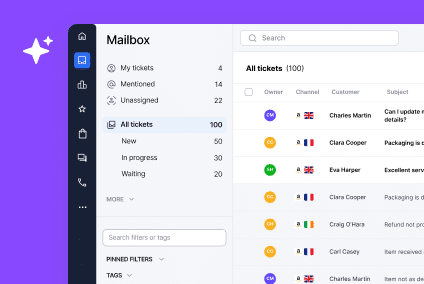How do you keep your Amazon performance metrics strong enough to win and keep customers? The answer lies in speed, consistency, and automation. More specifically, by aligning your support workflows with Amazon’s requirements, you can protect your account health, improve your ratings, and scale your business.
Let’s talk about how to do that quickly, easily and effectively, with these top tips on improving your Amazon seller rating.
Why Amazon performance metrics matter
Amazon closely monitors seller performance to make sure customers get the best shopping experience. Metrics such as order defect rate, late shipment rate, and customer response time directly affect your visibility and eligibility to win the Buy Box. On the flipside, poor scores can mean account suspensions or lost sales.
According to Amazon, sellers must respond to customer inquiries within 24 hours, including weekends and holidays (ouch). Falling short risks damaging both your seller rating and customer trust. But we all want weekends and holidays, right?
What this means for you: Fast responses are not optional on Amazon. They are a critical factor in your account health and long-term growth.
Learn more about Amazon performance metrics and why they matter to your business.
Manual vs automated responses: a comparison
Many sellers struggle with keeping up manually, especially when customer queries spike during peak seasons. Automation and integration can transform how you manage messages.
| Task | Manual Approach | Automated Approach |
| Customer response time | Hours or days | Seconds or minutes |
| SLA compliance tracking | Difficult, prone to errors | Monitored in real time |
| Message categorization | Manual sorting | Automatic tagging and routing |
| Response templates | Copy-paste replies | Smart, personalized automation |
| Scaling customer support | Requires more agents | Scales instantly without extra headcount |
With Amazon customer message automation, sellers can send faster, more accurate replies that align with Amazon’s requirements.
Staying ahead with SLA compliance
Every Amazon seller is bound by strict Service Level Agreements. Meeting these expectations is not only necessary for account health but also a competitive advantage.
Amazon SLA compliance means responding within Amazon’s required time frames and maintaining quality interactions. Sellers who consistently exceed SLAs see higher customer satisfaction and fewer negative reviews. And we all know what that means… more happy customers.
After all, SLA compliance is a key driver of trust. So, when sellers respond quickly, customers are more likely to leave positive feedback (and come back to shop with you again).
How helpdesk integrations speed up support
When support teams are juggling multiple inboxes, delays are inevitable. An Amazon helpdesk integration consolidates all your customer conversations into one shared workspace.
This means:
- No switching between Amazon and other sales channels
- Real-time syncing of order details
- Faster collaboration between agents
- Clear visibility of unresolved issues
The result? Faster replies on Amazon and improved seller performance metrics …without adding more overhead (crucially).
Automation tools that boost response rates
Automation helps sellers maintain compliance and keep response times low. With the right tools, you can:
- Set up smart auto-replies for common questions
- Prioritize urgent customer issues
- Track Amazon response time integrations in real time
- Measure improvements in support speed and efficiency
These features don’t just help sellers comply with Amazon’s policies. They improve the customer experience and drive higher satisfaction scores.
TL;DR and next steps
- Amazon performance metrics are critical to maintaining account health and sales growth
- Manual workflows slow down responses and increase the risk of SLA breaches
- Automation and integrations help sellers meet Amazon’s strict requirements with ease
- Faster replies improve customer satisfaction and seller ratings
Next step: explore automation tools that cut response times and improve your account health.
FAQs
What is Amazon’s response time requirement?
Amazon requires sellers to respond to customer messages within 24 hours, every day of the week. Faster replies often lead to better customer satisfaction and improved ratings.
How do integrations improve seller performance metrics?
Integrations consolidate all support channels, automatically sync order data, and enable real-time automation. This reduces response times, improves SLA compliance, and boosts seller metrics.
Ready to improve your performance metrics and scale your support? Book a Demo today to see how eDesk’s automation can transform your Amazon customer service




